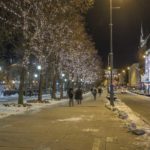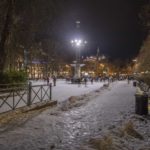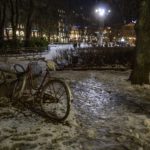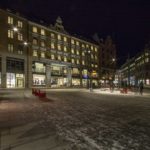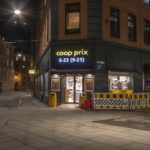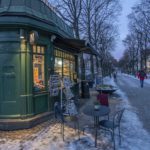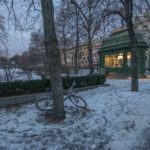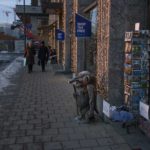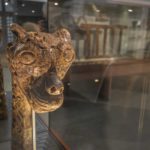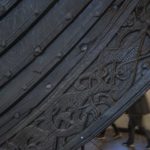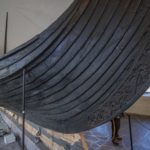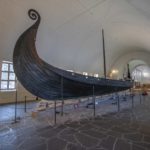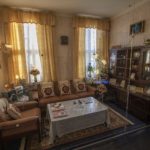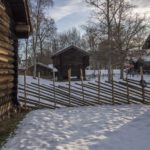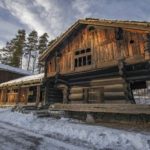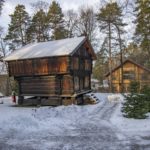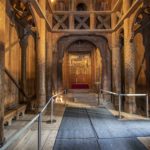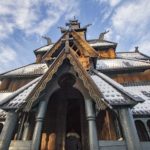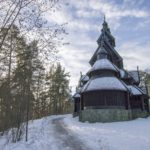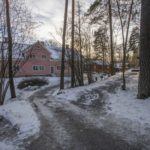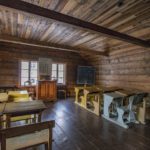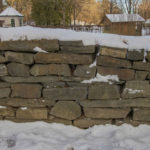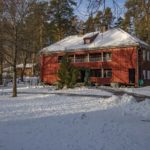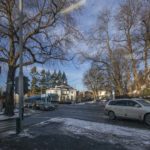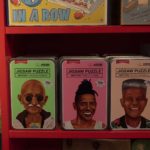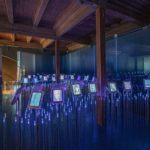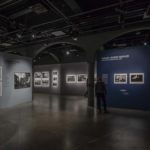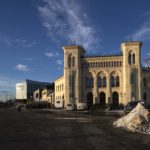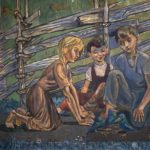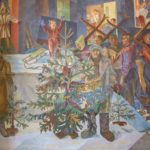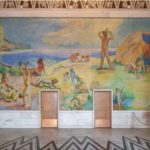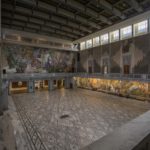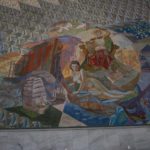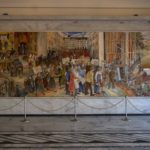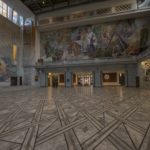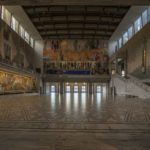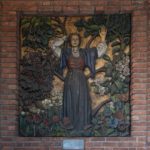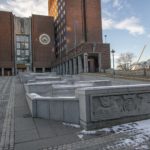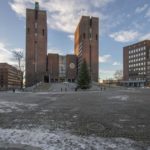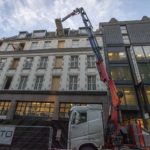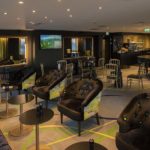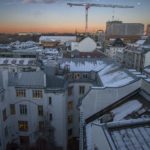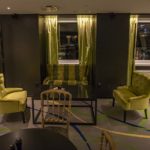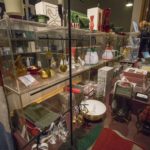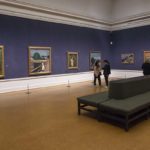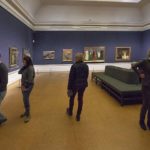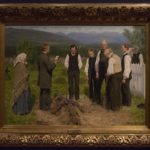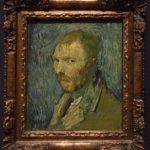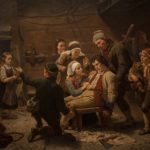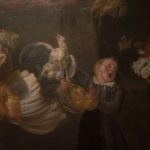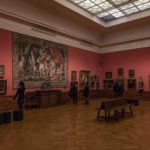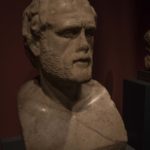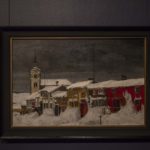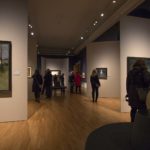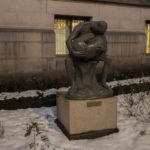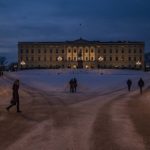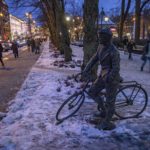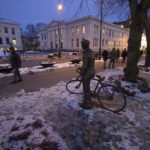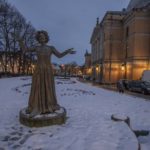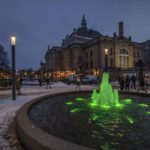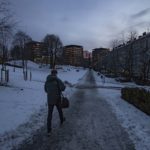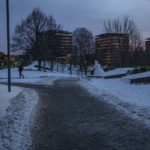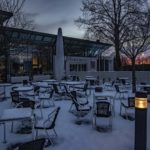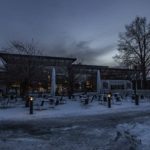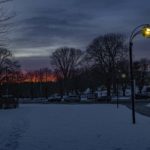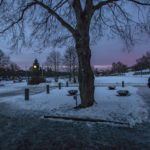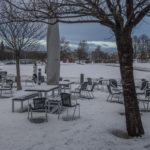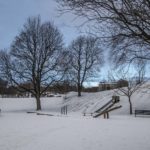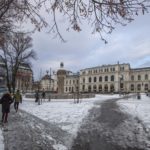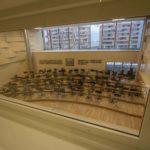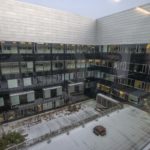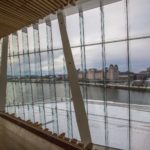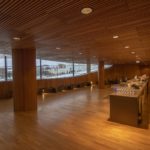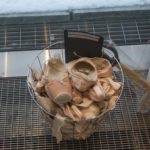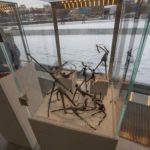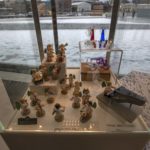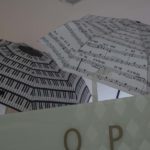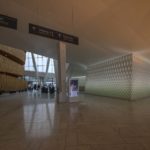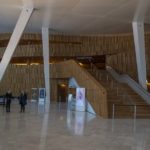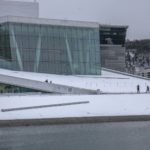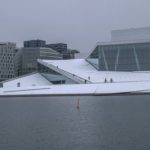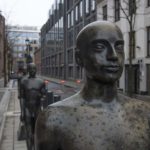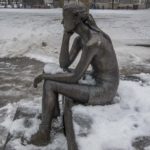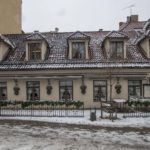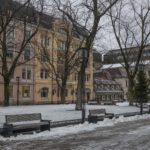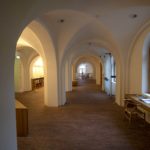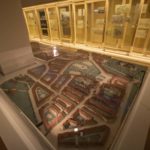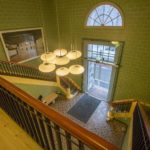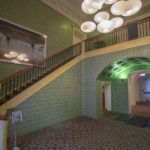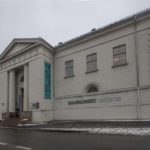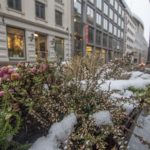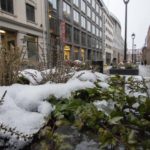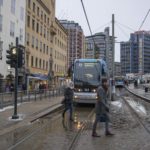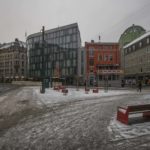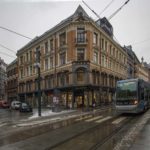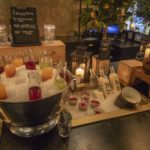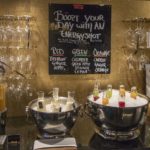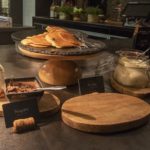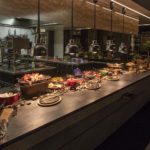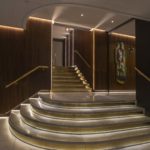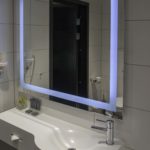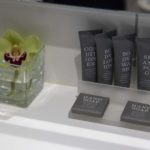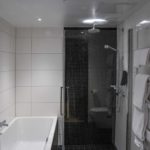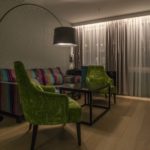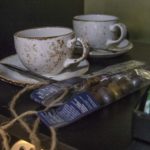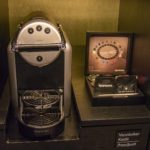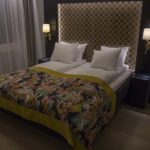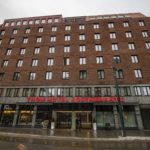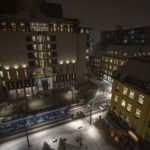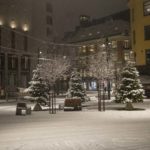I didn’t know much about the capital of Norway, apart from the fact that it was the location of the first full West End production of Les Misérables in Europe (mainland), boasts one of the most amazing opera houses in the world, and is home to three of the four versions of Edvard Munch’s ‘The Scream’. But that was enough for us to arrange a stay of three nights and take it from there.
Thon Hotel Rosenkrantz Oslo
In planning, we mapped out things we had an interest in, and chose a hotel that was pretty much in the thick of it all – Thon Hotel Rosenkrantz. As with our Tromsø accommodation choice of another Thon, this one offered the same perks of a complimentary buffet breakfast and a light evening meal (big bonuses when travelling in an expensive country).
We chose a business room that actually turned out to be a suite. But there was a surprising lack of shelves or drawers for unpacking suitcases, and what was there was above the wardrobe hanging space, which made it difficult to access (it would be impossible for anyone under 160cm). The bathroom was big, and there was a bath, which aided a good night’s sleep after a day in the cold.
The furnishings were lovely – the rainbow striped couch in particular drew much admiration from the FB friends. A good fridge tall enough to stand up wine bottles in was also a nice touch. The bed was equally as comfortable as the one in Tromsø – some sort of latex mattress with a ticking layer and then a whole duvet each.
Staff members were delightfully friendly and smiley, and all so helpful. Excellent but unobtrusive security in the foyer gave peace of mind, and guests needed a keycard to access floors.
Exploring the city
There is so much to see and do in Oslo, especially for those who are into museums and galleries. In summer I can imagine that it would offer even more for the active and enthusiastic. The Oslo Pass is great for visitors. They are available as a 24, 48 or 72 hour pass, and cover entry to pretty much all the city attractions as well as some that you can cover in day trips, plus public transport within the city zones.
Architecture Museum
First up was the National Museum of Art, Architecture and Design, whose different branches are housed in several locations in the city. We started with the Architecture Museum, housed in the first bank building in Oslo, which underwent an extensive restoration and extension that cost millions of Norwegian Krone and opened in 2008. Sverre Fehn was the architect on this project (we had seen his work in the Nordic pavilion at the Venice Biennale). Unfortunately, the extension was closed in preparation for an installation, but we looked through the glass door, drawn to the perfectly aligned floorboards and soaring tree-trunk columns. There was an informative and interesting film showing upstairs on the whole transformation process, and were glad we watched that before looking through the space; it gave us a greater appreciation for the whole thing. The toilets were amazing, with limestone surfaces and large cubicles, each with their own washbasin. These were located in what were the old vaults of the bank, so the space was clearly delineated with arched doorways.
Oslo Opera House
We continued walking through the light rain that was sometimes snow to the Oslo Opera House in time for the 1pm tour in English. This was the most impressive opera house we have ever seen, in design, beauty and function. Our guide was a former ballet dancer who retired at 41 on a government pension (singers get to go at 52, and musicians the same age as everyone else in the country – 67). The foyer is a communal space for everyone; unlike many opera houses, it is open regular business hours and anyone can go and hang and just use the free wifi. The floor is marble and there are so many undulating ‘walls’ of oakwood that it feels like you are in nature (more about the design of the building). The architects were chosen from a blind competition, and the company Snohetta were the successful bid.
There are so many extraordinary spaces that are a part of this building: 3 performance spaces (seating 1,350, 400 and 200), workshops where they build and make everything used (there are 50 people in the costume department alone), practice rooms and rehearsal studios, offices, canteens, green rooms, all providing a second home for the 600 people who work there. It cost 3.3 billion NOK to build (€400 million), and the state covers 85% of the annual running costs of it all, the other 15% comes from donations and subscriptions. What a forward thinking country to fund the arts and its artists so well! Our tour of the Oslo Opera House was nearly as impressive as the Northern Lights!
Munch Museum
Central Station was nearby the opera house, so we caught the metro a couple of stops to Munch Museum and spent some time there. This is another example of this country being proud of its artists, and it is filled with Munch’s works, including one of the four versions of his most famous work, ‘The Scream’ (this one is rendered in pastel). One highlight of this visit had nothing to do with the artist, it was actually seeing the sun set, which we had not been able to do for over a week!
Central Oslo
Caught the metro back the way we had come to the National Theatre, and wandered around that busy precinct as the snow drifted down. It was magical with the remainder of the unmelted snow at the bases of trees and statues and the streetlights reflected in the shiny, wet footpaths through the park. At at one end of this stretch of park and paths stands the Royal Palace, at the other the Norwegian Parliament, and in between the theatre, gallery, restaurants, bike paths and ice rink feed the active, social and artistic drives of the city’s people.
The National Gallery (which is part of the National Museum) was about to close on the 13 January in preparation for a grand new opening in a new venue in 2020 (moving 130,000 objects to a new home takes time!). Due to the planned closure they had extended hours during our visit, and it was still crowded at 5:30pm. Once again, the new National Museum is an example of how civilised nations value the arts, and this museum will house all of the branches of the museum currently spread throughout the city. No fewer than 6,000 works will be on display in the permanent exhibition of the gallery.
Oslo City Hall
The next day we continued our explorations of the city on foot. I would not have thought that a city hall would be on our list, but Oslo’s certainly was. What a building! It was built between 1931 and 1950, with some pauses in construction during the war. Art deco inspirations were apparent throughout, and it did the job of a structure of high status and was definitely ‘for the people’. The interiors were reminiscent of the murals in Mexico City, with the main hall having paintings depicting Norway and Oslo between the wars and during occupation, with many powerful paintings showing strength and solidarity during the resistance. One room was closed for a private function, a wedding – who wouldn’t want to get married at a city hall such as this one?!
Nobel Peace Center
The Nobel Peace Center was just around the corner from City Hall, and it was a sobering place to visit. Downstairs was an exhibition of photographs documenting the human rights violations happening in the world today (and in recent history), and upstairs was this year’s exhibit about the winners of this year’s Nobel Peace Prize – Dr Denis Mukwege Mukengere and Nadia Murad, “for their efforts to end the use of sexual violence as a weapon of war and armed conflict.” The part of this exhibition that focused on the facts and the quotes of people who had suffered in this way was incredibly moving. These quotes were from men, women and children, from WWII to now. There were also photographic artworks that were representations of this violence. It took a while to catch our breath after this one.
The final display was a darkened room dedicated to all the winners of the Nobel Peace Prize. It was a wave of faces on tablets that sensed your approach, and chimed a note before dissolving to give information on the recipients. It became a cacophony of chimes as you walked around the room, approaching different tablets, harmonious and peaceful, which was needed after the harrowing experiences of the previous exhibitions!
Norwegian Museum of Cultural History
We continued to use our Oslo Pass and caught the number 30 bus to Bygdøy, which was a lovely trip past very European buildings that reminded us of Barcelona and Latvia (art nouveau and a bit of rococo). This architecture was juxtaposed with that of Bygdøy, with its gorgeous, very Norwegian, white wooden houses that looked like they were out of an Oslo design magazine.
It was amongst all this that the Norwegian Museum of Cultural History laid. It was the world’s first outdoor museum (thanks to King Oscar II who in 1881 had the first 5 houses moved to this park). We didn’t have our crampons on our shoes, so we took things gingerly – the ice can be treacherous. There were a few buildings and tracks under repair, and a couple of new installations fenced off, but we certainly still got an insight into life in Norway through the ages and different socio-economic spheres – especially with the apartment block fitted out in different time periods in each apartment from 1879 to 2002. The museum displays buildings from the Middle Ages (the Gol Stave Church from 1200 is a highlight) to the 20th century.
Viking Ship Museum
From the cultural history museum we walked ‘next door’ to the Viking Ship Museum. I had previously thought that all Viking funerals were the burning type – but these ships were burial ships and they were buried with important corpses and many riches aboard. Included in this museum was an engaging film that spanned 3 walls and the roof of one branch of the cross-like building housing the treasures.
Our final night in Oslo was spent enjoying some fine quality Indian take away from Benares Indisk Restaurant (some delicious spicy vegetables) and some wine bought at the vinmonopolet. These wine shops are owned by the government and are the only place in Norway to purchase wine outside of a restaurant. While there were no bargains to be had like we would find at Dan Murphy’s, it was certainly cheaper than purchasing when dining out.
[SIDE NOTE: Oslo airport was a dream on departure. It took only 20 minutes from the moment we walked through the door to clearing security after check in. We did do the self check in and bag drop, so avoided the line for that, which I can highly recommend.]
Next, on to Stockholm…
Accommodation: Thon Hotel Rosenkrantz
Click on any image below to view as gallery
- Oslo street in January, Norway
- Skating rink, Oslo, Norway
- Old bike in the snow, Oslo, Norway
- Night square, Oslo, Norway
- Coop Prix, Oslo, Norway
- Outdoor tables and chairs, Oslo, Norway
- Snow bike in Oslo, Norway
- Tax free shopping, Oslo, Norway
- Figurehead at the Viking Museum, Oslo
- Detail of the prow of the Viking ship, Viking Museum, Oslo
- Prow of Viking burial ship, Viking Museum, Oslo
- Burial viking ship, Viking Museum, Oslo
- Apartment building, Norwegian Museum of Cultural History, Oslo
- Fence, Norwegian Museum of Cultural History, Oslo
- Old farmhouse, Norwegian Museum of Cultural History, Oslo
- Timber buildings at Norwegian Museum of Cultural History, Oslo
- Interior of Gol Stave Church, Norwegian Museum of Cultural History, Oslo
- Close up of Gol Stave Church, Norwegian Museum of Cultural History, Oslo
- Wide shot of 1200’s Gol Stave Church, Norwegian Museum of Cultural History, Oslo
- Path in the Norwegian Museum of Cultural History, Oslo
- School room, Norwegian Museum of Cultural History, Oslo
- Drystone wall, Norwegian Museum of Cultural History, Oslo
- Street in the Norwegian Museum of Cultural History, Oslo
- Red house in the Norwegian Museum of Cultural History, Oslo
- Corner in Bygdøy, Oslo, Norway
- Jigsaw puzzles at the Nobel Peace Center shop, Oslo
- Nobel Peace Prize winner gallery, Nobel Peace Center, Oslo
- Human rights violations exhibition, Nobel Peace Center, Oslo
- Nobel Peace Center, Oslo, Norway
- Mural with children and blue birds, Oslo City Hall, Norway
- Christmas tree mural, Oslo City Hall, Norway
- Naked beach mural, Oslo City Hall, Norway
- View of main hall from the balcony, Oslo City Hall, Norway
- Staircase mural, Oslo City Hall, Norway
- Mural in the main hall, Oslo City Hall, Norway
- Marble floors and murals of the main hall, Oslo City Hall, Norway
- Main hall, Oslo City Hall, Norway
- Frigg Odin, wife of the god, Odin, Oslo City Hall, Norway
- Driveway of Oslo City Hall, Norway
- Oslo City Hall, Norway
- Top floor renovations, Oslo, Norway
- Wide shot of the Club Lounge, Thon Hotel Rosenkrantz Oslo, Norway
- Rooftop view from the Club Lounge, Thon Hotel Rosenkrantz Oslo, Norway
- Club Lounge of Thon Hotel Rosenkrantz Oslo, Norway
- Museum shop, National Gallery, Oslo, Norway
- Wide shot of Munch room, National Gallery, Oslo, Norway
- Nic looking at paintings, National Gallery, Oslo, Norway
- ‘Peasant Burial’ by Erik Werenskold 1883-1885, National Gallery, Oslo, Norway
- Van Gogh self portrait, 1889-1890, National Gallery, Oslo, Norway
- ‘Seated Man’ by Cézanne, 1889, National Gallery, Oslo, Norway
- ‘The Return of the Bear Hunter’ by Adolf Tidemand, National Gallery, Oslo, Norway
- Child screaming about a chicken, National Gallery, Oslo, Norway
- Wide shot of gallery, National Gallery, Oslo, Norway
- Bust of Olympiodoros, unknown artist, National Gallery, Oslo, Norway
- “Street in Roros in Winter’ 1903 by Harald Sohlberg, National Gallery, Oslo, Norway
- Interior, National Gallery, Oslo, Norway
- Love clinch statue, National Gallery, Oslo, Norway
- Royal Palace, Oslo, Norway
- Bicyclist station, Oslo, Norway
- Rear shot of bicycle statue, Oslo, Norway
- Statue of Norwegian actor, Wenche Foss, Oslo, Norway
- Green fountain at the National Theatre, Oslo, Norway
- Walking to the metro station, Oslo, Norway
- Path cleared of snow on the walk to the station, Oslo, Norway
- Munch Museum Cafe at sunset, Oslo, Norway
- Munch Museum, Oslo, Norway
- Sunset at Munch Museum, Oslo, Norway
- Mauve sky outside the Munch Museum, Oslo, Norway
- Munch Museum outdoor cafe, Oslo, Norway
- Playground in the snow, Oslo, Norway
- Walking through the park, Oslo, Norway
- Recording studio, Oslo Opera House, Norway
- Backstage courtyard, Oslo Opera House, Norway
- View of Oslo Harbour from Oslo Opera House, Norway
- Upstairs bar, Oslo Opera House, Norway
- Used pointe shoes, Oslo Opera House, Norway
- Ballet figurines for sale at the Oslo Opera House, Norway
- Orchestra figurines for sale at the Oslo Opera House, Norway
- Musical umbrellas, Oslo Opera House, Norway
- Foyer of Oslo Opera House, Norway
- Oakwood walls, Oslo Opera House, Norway
- Close up of Oslo Opera House, Norway
- Oslo Opera House, Norway
- Line of statues, Oslo, Norway
- Headphones statue, Oslo, Norway
- Oldest inn in Oslo, Norway
- Snowy benches, Oslo, Norway
- Arched basement of the National Architecture Museum, Oslo, Norway
- Architecture model in the National Architecture Museum, Oslo, Norway
- Entry foyer of the National Architecture Museum, Oslo, Norway
- Staircase of the National Architecture Museum, Oslo, Norway
- Exterior of the National Architecture Museum, Oslo, Norway
- Street flowers, Oslo, Norway
- Snow in flower boxes, Oslo, Norway
- Pedestrians crossing the tramlines, Oslo, Norway
- Tiger statue near the Thon Hotel Rosenkrantz Oslo, Norway
- Square outside the Thon Hotel Rosenkrantz Oslo, Norway
- Tram stop outside the Thon Hotel Rosenkrantz Oslo, Norway
- Breakfast energy shots, Thon Hotel Rosenkrantz Oslo, Norway
- Energy shot station for breakfast, Thon Hotel Rosenkrantz Oslo, Norway
- Breakfast cheeseboard, Thon Hotel Rosenkrantz Oslo, Norway
- Nutella and pancakes for breakfast, Thon Hotel Rosenkrantz Oslo, Norway
- Stunning breakfast station, Thon Hotel Rosenkrantz Oslo, Norway
- Foyer of Thon Hotel Rosenkrantz Oslo, Norway
- Bathroom mirror, Thon Hotel Rosenkrantz Oslo, Norway
- Bathroom products, Thon Hotel Rosenkrantz Oslo, Norway
- Bathroom in the business room, Thon Hotel Rosenkrantz Oslo, Norway
- Sitting area of the business room, Thon Hotel Rosenkrantz Oslo, Norway
- Coffee cups, Thon Hotel Rosenkrantz Oslo, Norway
- Coffee machine in the business room, Thon Hotel Rosenkrantz Oslo, Norway
- Bedroom of the business room, Thon Hotel Rosenkrantz Oslo, Norway
- Thon Hotel Rosenkrantz Oslo, Norway
- View from the business room in Thon Hotel Rosenkrantz Oslo, Norway
- True Christmas trees, Oslo, Norway

